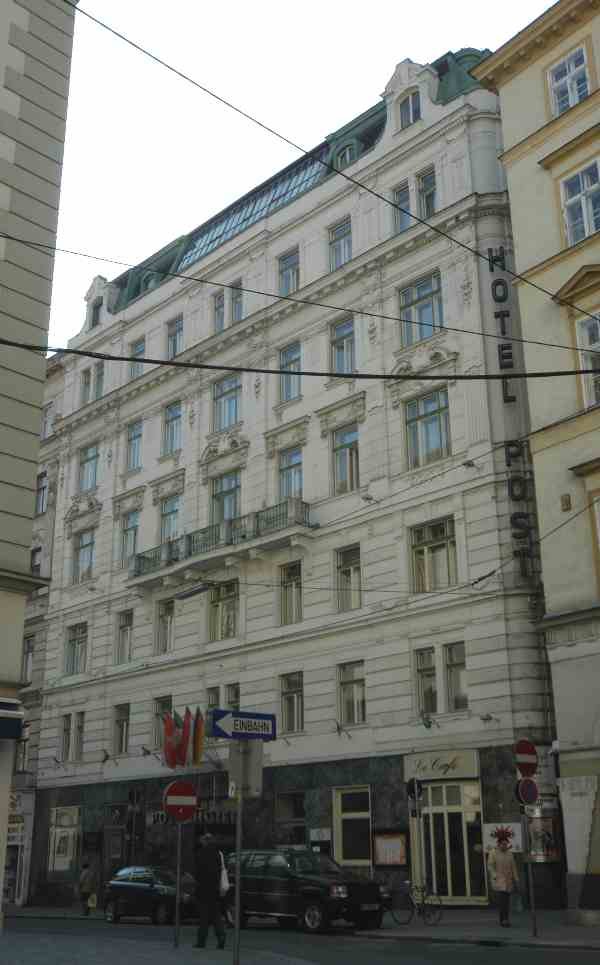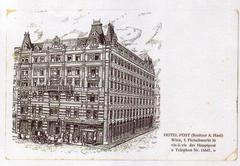
Wiener Kammeroper Visiting Hours, Tickets, and Guide to Vienna Historical Sites
Publication Date: 14/06/2025
Introduction to the Wiener Kammeroper
Situated in Vienna’s historic 1st district, the Wiener Kammeroper is a renowned chamber opera house acclaimed for its intimate performances and innovative artistic vision. Established in 1954 by Hans Gabor, the Kammeroper has carved out a unique place within Vienna’s celebrated musical landscape by focusing on rarely performed works, contemporary music, and nurturing emerging talent. Unlike the city’s grand opera venues, the Kammeroper provides a close, immersive experience for audiences, with fewer than 300 seats in its historic cellar theater at Fleischmarkt 24.
Thanks to its central location, visitors can easily combine a performance with exploration of Vienna’s most famous historical sites, such as St. Stephen’s Cathedral and the Hofburg Palace. This comprehensive guide will provide you with essential information about the Kammeroper’s history, architectural features, programming, visitor information, and practical tips to enhance your Vienna opera experience. For current schedules, ticket purchases, and event updates, consult the official Theater an der Wien website and the Audiala app.
Discover the dynamic tradition and modern spirit of Vienna’s chamber opera scene at the Wiener Kammeroper—a cultural gem that continues to captivate audiences and inspire artists (Wien Geschichte Wiki, Vienna Classic, Theater an der Wien).
Table of Contents
- Introduction
- Historical Overview and Evolution
- Architectural Character and Setting
- Cultural Significance
- Programming and Artistic Direction
- Performances and Audience Experience
- Practical Visitor Information
- Nearby Attractions and Travel Tips
- Tips for an Enjoyable Visit
- Sustainability and Safety
- Frequently Asked Questions (FAQ)
- Conclusion and Recommendations
- Sources and Further Reading
Historical Overview and Evolution
Founding and Early Years (1954–1961)
Founded by Hans Gabor in 1954, the Wiener Kammeroper emerged as Vienna’s platform for innovative and intimate opera productions. Its debut performance was Rossini’s Il signor Bruschino at the Konzerthaus, immediately establishing a reputation for presenting repertoire outside the mainstream (Wien Geschichte Wiki). In its early years, the company operated as a mobile ensemble, staging performances at various venues across Vienna, which allowed for artistic experimentation but highlighted the need for a permanent home.
Establishment of a Permanent Venue (1961–1984)
In 1961, the Kammeroper settled at Fleischmarkt 24, converting a historic cellar theater into a permanent venue. This move enabled a stable artistic identity, expanded programming, and closer engagement with audiences. The intimate setting, with just over 300 seats, provided ideal conditions for chamber opera and close performer-audience interaction (Wien Geschichte Wiki).
Renovation and Modernization (1984)
A major renovation in 1984 brought technical upgrades, improved acoustics, and enhanced staging possibilities, establishing the Kammeroper as a leading chamber opera venue in Vienna.
From Independence to Collaboration (1984–2012)
During this period, the Kammeroper flourished, presenting a wide spectrum of works—from baroque rarities to world premieres—while launching the careers of numerous young artists. Occasional performances at other venues like the Schönbrunner Schlosstheater expanded its reach (Wien Geschichte Wiki).
Integration with Theater an der Wien (2012–Present)
Since autumn 2012, the Kammeroper has operated under the auspices of the Theater an der Wien, strengthening its artistic collaborations and institutional support. The venue now serves as a platform for smaller-scale productions, contemporary works, and projects featuring young artists, ensuring its vitality and distinct identity within Vienna’s operatic ecosystem (Visiting Vienna).
Recent Developments
As of the 2024/2025 season, the Kammeroper continues to present a diverse mix of historical rarities, contemporary works, and world premieres. Its season typically runs from late September to late June, often featuring innovative projects and performances by the Young Ensemble (Visiting Vienna).
Architectural Character and Setting
Location and Urban Context
The Kammeroper stands at Fleischmarkt 24, in Vienna’s UNESCO-listed Innere Stadt. Its location places it among a blend of Baroque, Biedermeier, and 19th-century architecture, making it a beautiful example of adaptive reuse in Vienna’s historic center (Evendo).
Architectural Features
The building’s understated 19th-century façade harmonizes with neighboring historic structures (Vienna Classic). Inside, the 300-seat auditorium prioritizes acoustics and sightlines, creating an intimate and immersive setting for chamber opera (Wien.info).
Preservation and Adaptation
Through careful renovations and technical modernization, the Kammeroper has maintained its historic ambiance while meeting the needs of contemporary performances (Vienna Classic).
Cultural Significance
Artistic Mission
From its inception, the Kammeroper has championed rarely performed works, contemporary composers, and experimental productions. It has premiered Austrian and world debuts, staged Mozart cycles, and revived traditional Viennese Singspiele (Wien Geschichte Wiki).
Platform for Emerging Talent
The Kammeroper is a launchpad for young artists, offering significant stage experience and promoting the winners of the Hans Gabor Belvedere Singing Competition. The Young Ensemble Theater an der Wien (JET) brings together international emerging singers for leading roles (Vienna Classic).
Community and Audience Engagement
The venue’s central location and accessible pricing foster a diverse, engaged audience, from seasoned opera lovers to students and first-time attendees. Its commitment to inclusivity and audience development strengthens Vienna’s reputation as a global music capital (Evendo).
Programming and Artistic Direction
Season Highlights
Each season, the Kammeroper presents four to five new productions, alongside portrait concerts, matinées, and special events. The repertoire spans baroque, classical, and contemporary works, emphasizing premieres and lesser-known operas (Concerti).
The 2024/2025 program includes Martines’ Isacco, Rossini’s L’occasione fa il ladro, Strauss’ Die Fledermaus, and Unsuk Chin’s Alice in Wonderland (Theater an der Wien).
Notable Productions
The Kammeroper’s history includes premieres and innovative reinterpretations, such as George Tabori’s production of Leoncavallo’s Bajazzo and recent stagings of contemporary operas (Vienna Concert).
Performances and Audience Experience
Staging and Production
Directors employ creative staging within the compact auditorium, crafting immersive experiences that maximize the intimacy of the space (Vienna Unwrapped).
Musical Approach
Performances are often accompanied by chamber orchestras, providing nuanced interpretations of both classic and contemporary scores. Guest conductors and musicians regularly collaborate with young artists, ensuring artistic excellence.
Accessibility
Most productions offer English surtitles, making performances accessible to international visitors (Vienna Unwrapped).
Special Events
Portrait concerts, masterclasses, and family workshops enrich the season and deepen engagement with opera (Theater an der Wien).
Practical Visitor Information
Location and Transportation
- Address: Fleischmarkt 24, 1010 Vienna (Vienna Unwrapped), centrally located near Stephansplatz and the Hofburg.
- Public Transit: U-Bahn lines U1/U4 (Schwedenplatz), U4 (Stadtpark), tram lines 1 and 2 (Stubenring), and bus lines serve the area (Evendo).
- Parking: Nearby BOE-Garage at Morzinplatz 1 (Theater an der Wien).
Tickets and Visiting Hours
- Box Office: Open Tuesday–Saturday, 10:00 AM–6:00 PM, and on performance days until curtain.
- Booking: Purchase online via Theater an der Wien, by phone, or at the venue. Advance booking is strongly recommended due to limited seating (TourMyCountry).
- Prices: Range from €15–€60, with discounts for students, seniors, and groups.
Accessibility
The venue offers accessible entrances and seating for visitors with disabilities. Contact the box office in advance for specific needs (Vienna Unwrapped).
Facilities
- Cloakroom: Complimentary; large bags and coats must be checked.
- Dress Code: Smart casual is recommended; avoid overly casual attire (Wiener Staatsoper).
- Refreshments: Available in the foyer; numerous restaurants and cafés are nearby (Evendo).
Nearby Attractions and Travel Tips
- St. Stephen’s Cathedral: Vienna’s iconic Gothic cathedral.
- Hofburg Palace: Former imperial residence and museum complex.
- Jewish Museum Vienna: Insight into the city’s Jewish heritage.
- Hoher Markt Square: Historic square with the famous Anker Clock (TourMyCountry).
- Dining: Wide range of options in the Innere Stadt; reservations recommended for pre-show meals.
Tips for an Enjoyable Visit
- Arrive at least 20–30 minutes early to settle in and enjoy the ambiance.
- Make use of English surtitles and program booklets for a richer experience.
- Use apps like GPSmyCity for self-guided tours of the area.
- Explore Vienna’s historic core before or after your visit.
- Photography and recording are not permitted during performances.
Sustainability and Safety
Vienna encourages eco-friendly travel; use public transportation, walk, or bike to the venue. The Kammeroper supports sustainable mobility initiatives (WienMobil). For safety, all large bags must be checked. Refer to the official website for current health and safety protocols.
Frequently Asked Questions (FAQ)
Q: How do I buy tickets?
A: Purchase online, at the box office, or by phone. Advance booking is recommended (Theater an der Wien).
Q: What are the visiting and box office hours?
A: Box office: Tuesday–Saturday, 10:00 AM–6:00 PM; on show days, open until curtain. Venue doors open before performances.
Q: Is the venue accessible?
A: Yes, with accessible entrances and seating; contact the theater for specific requirements.
Q: What is the dress code?
A: Smart casual attire is recommended.
Q: Are guided tours available?
A: Occasionally, during special events or festivals—check the official website for announcements.
Q: What are some nearby attractions?
A: St. Stephen’s Cathedral, Hofburg Palace, and Hoher Markt are all within walking distance.
Conclusion and Recommendations
The Wiener Kammeroper is a vital part of Vienna’s cultural life, blending tradition with innovation and offering a welcoming atmosphere for opera lovers and newcomers alike. Its central location, diverse programming, and commitment to emerging talent make it an essential stop for anyone exploring Vienna’s rich musical heritage. For the latest updates, ticket offers, and more, download the Audiala app and follow the Kammeroper and Theater an der Wien on social media.
Plan your visit to the Wiener Kammeroper and experience the vibrancy of Vienna’s chamber opera tradition!
Sources and Further Reading
- Wien Geschichte Wiki
- Vienna Classic
- Vienna Concert
- Concerti
- Theater an der Wien
- Vienna Unwrapped
- Travelright
- TourMyCountry
- Evendo
- Wien.info
- Wiener Staatsoper
- Wikipedia
- GPSmyCity






















































































































































